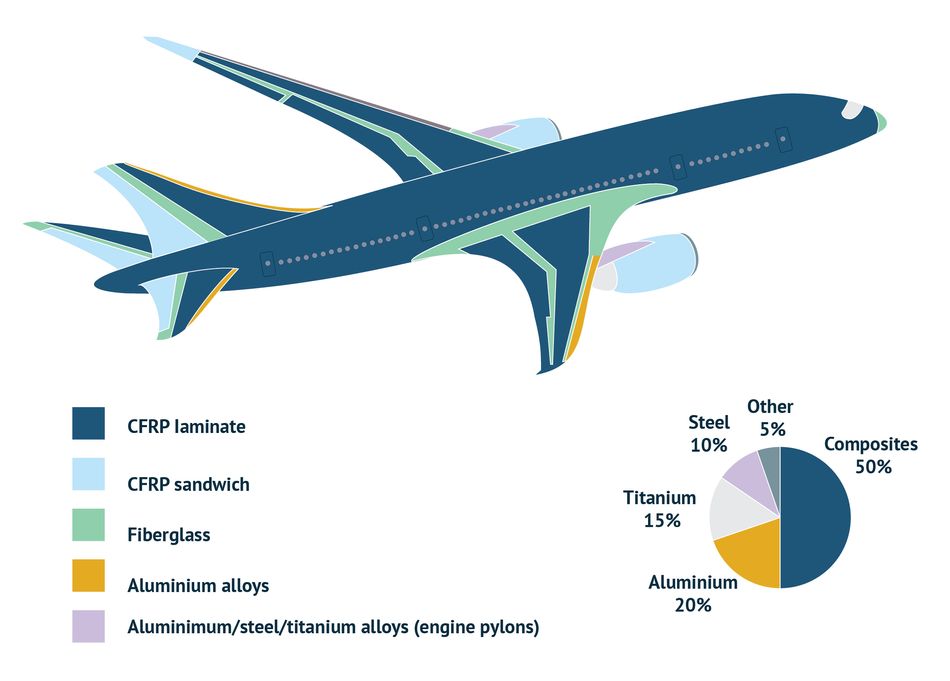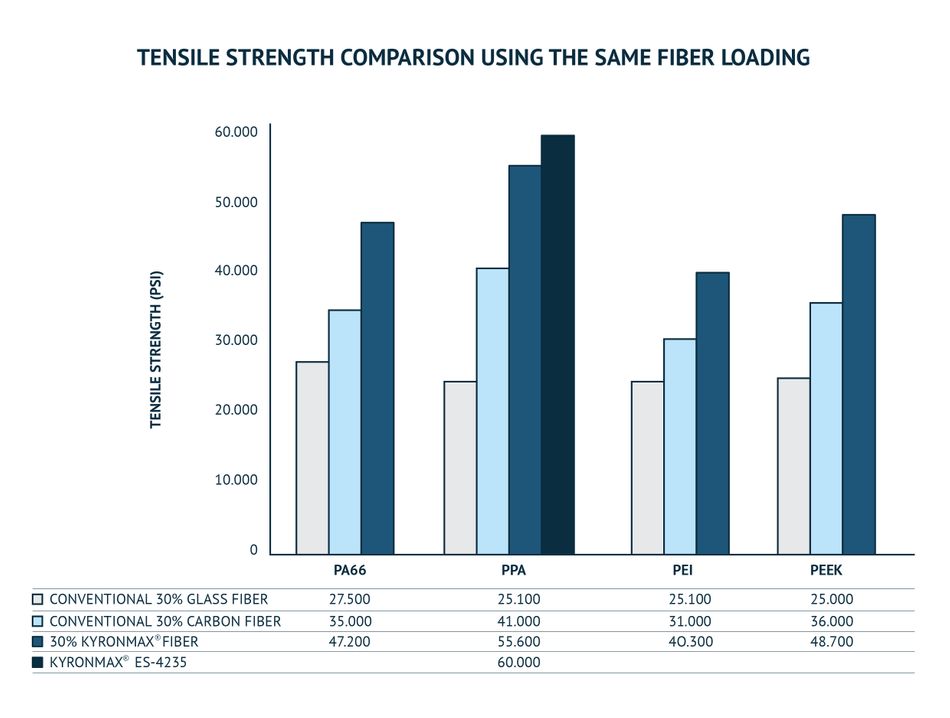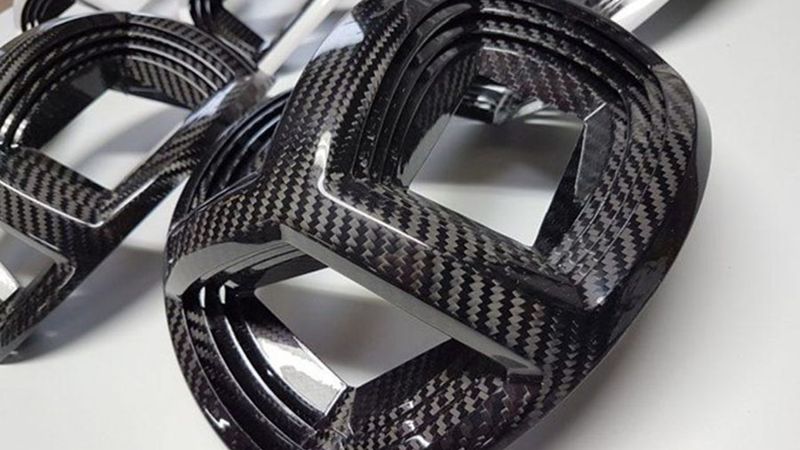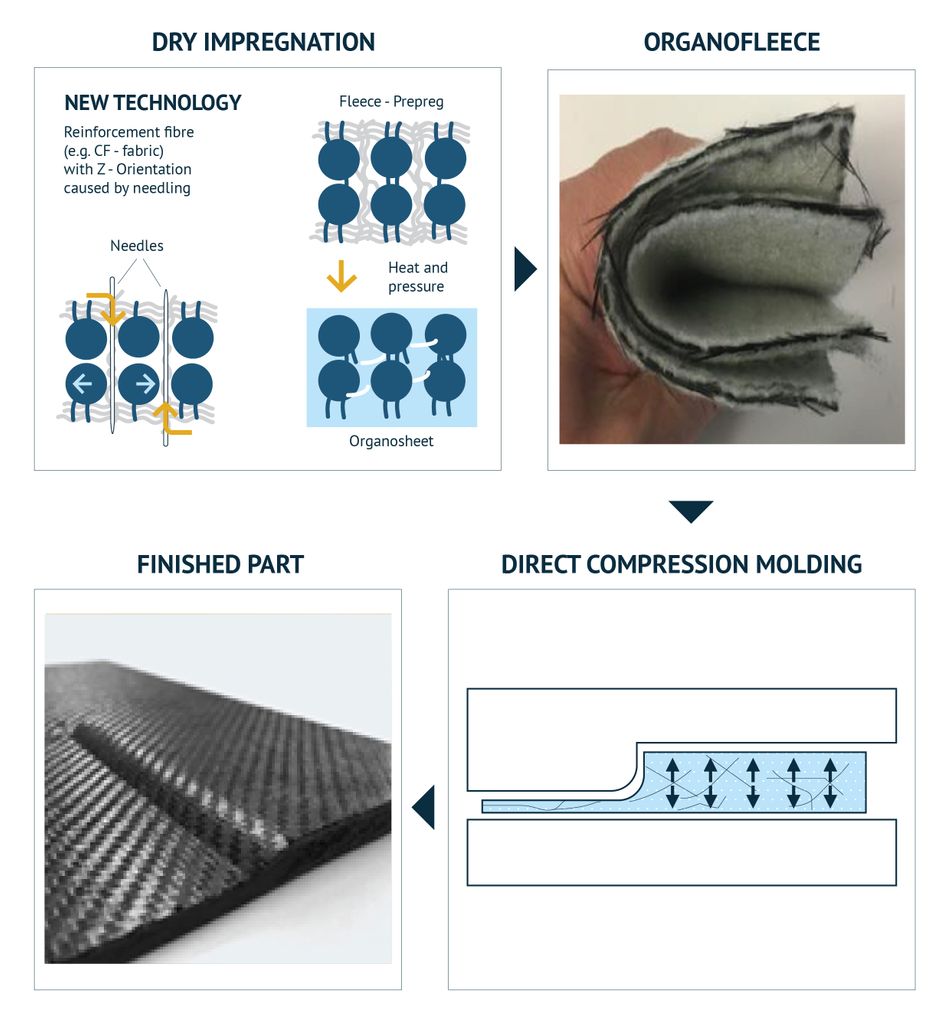Discovering advanced composites: How a new generation of composite materials is revolutionizing engineering
Lightweight composites deliver a clever combination of optimal mechanical performance with circularity.
What is a composite?
Composites are materials that consist of two main constituents. Typically, one of the two constituents is known as the reinforcing phase, while the other is called the matrix. The reinforcing phase can be made up of particles, fibers, platelets, or flakes. The matrix is continuous and usually constituted by either polymers, metals, or ceramic materials. The two constituents of a composite are statistically homogeneous at the macroscopic level and heterogeneous at the microscopic level.[1]
In general, the main advantage of using composites is the possibility of combining the properties of different individual constituents into a single material. Composites can be tailored to specific applications to provide optimized performance. Their properties are unattainable by using monolithic materials such as steel, aluminum, or plastics. Specific properties can be obtained by varying simple parameters, such as the volume fraction of components, the particle or fiber size, their morphology, and their distribution in the matrix.[2] This is especially significant in the context of energy-saving materials for automotive and aerospace, where lightweight composites can combine optimal mechanical performance with reduced fuel consumption.[3]

Surprisingly, many natural materials are composites. You can think of bone, composed of hard crystals of hydroxyapatite dispersed in a collagen matrix. Another everyday example of a natural composite is wood, which is made up of a stiff lignin matrix incorporating flexible cellulose fibers. Wood is a good example to illustrate the anisotropy of fiber-reinforced composites. Anisotropy means that the mechanical properties of a material, such as its tensile strength, stiffness, and toughness, vary depending on the direction of the deformation. Due to the alignment of the fibers within the matrix, their reinforcing effect is maximized in the direction parallel to their axis, or longitudinal direction.
Historically, composites have been employed by mankind since the early days of human civilization. You will be surprised to know that one of the first uses of composites dates back to ancient Mesopotamia. Starting from 1500 B.C., a mixture of mud and straw was used as a strong and durable material for construction. It was only in the early 20th century, however, that the rapid development of synthetic polymers (such as vinyl, polystyrene, phenolic resins, and polyester) determined the rise of composites as we know them today.[4]
During World War II, the need for lightweight materials for military aircraft led to the development of the first glass fiber-reinforced plastic, using phenolic resin as the matrix material. Due to their exceptional strength and transparency to radio frequency, these composites were used for the first time in the Havilland Mosquito Bomber of the British Royal Air Force.[1] Research and development in the field of advanced composites in recent years has led to a rapid improvement of the properties and applications of composite materials.

Challenges of traditional composites
Despite their outstanding mechanical and functional properties, traditional composite materials present several drawbacks. Many of these are related to their manufacturing processes, which are often expensive, limited reproducibility, labor intensive, difficult to scale up, and require large amounts of energy.
In particular, in fiber-reinforced polymer matrix composites, the fibers need to be precisely positioned to control the mechanical properties of the final components.[5] One of the most common approaches for the manufacturing of such composites is the hand layup technique. In this approach, fibers are laid onto a mold by hand and the resin is sprayed or brushed on. You should keep in mind that thermoset polymers are cured at relative high temperatures and require pressure. For this reason, the manufacturing processes of traditional composites often require the use of expensive autoclaves.[1]
Besides manufacturing challenges, traditional composites can fall short when it comes to their mechanical performance. This is because composites are vulnerable to several kinds of defects. Manufacturing defects occur during the composite fabrication process. For example, porosity, i.e., the presence of small voids in the matrix, can arise due to non-optimal conditions during the resin curing process. Before curing, hand- or machine-preparation of the resin-impregnated fibers can introduce foreign bodies inside the composite material. Fiber misalignment during manufacturing can prevent the optimal packing of reinforcing fibers, thus producing inhomogeneous material properties.[6]
Lastly, another significant challenge associated with traditional composites is related to circular economy and sustainability. As you know, the depletion of resources and the increase in waste production are urgent global issues. One of the environmental advantages of composites compared to traditional materials is their long lifetime and high resistance. To this day, however, there are limited established solutions for the recycling of thermoset matrix composites, although technologies for composite recycling are progressing quickly. The Mitsubishi Chemical Group, one of the largest suppliers of composites in the world, is currently capable of recycling thermoset composites on an industrial scale.
The main issue with composite recycling is the homogeneous incorporation of the reinforcing component within the matrix. The two components are often challenging to separate without damage. In addition, the use of thermoset polymers makes repurposing the existing matrix extremely difficult. Most composite recycling processes involve breaking the material into its constituents, which leads to the loss of specific material properties. Furthermore, due to the severe degradation of the components, the recycling process is often economically unfavorable. For these reasons, the vast majority of composites end up in landfills or is being incinerated.[7]
Recently, bio-based thermoset resins are introduced as a matrix polymer that are able to meet the required performance characteristics of aerospace. In time, these resins will find their way into various industries to reduce the overall material carbon footprint.
The new generation of composites
The increasing demand for lightweight and high-strength materials in industrial fields such as aerospace, automotive, and renewable energy production is driving the development of advanced composite materials. As mentioned, one of the main challenges associated with traditional composites is the high cost of production, labor intensive, and difficult processability. Furthermore, the use of thermoset polymers, such as phenolic and epoxy resins, makes recycling challenging. For these reasons, a new generation of cutting-edge composites is being developed to deal with these challenges.
First of all, you should recall the difference between thermoset and thermoplastic polymers. Thermoset polymers, or resins, are produced from a liquid precursor. The precursor undergoes an irreversible hardening process, also known as curing, in the presence of heat and/or a suitable catalyst. Typically, composites produced with thermoset matrices have high strength and heat resistance. However, they can be more brittle and possess lower impact resistance. Because the resin hardening process is irreversible, they are difficult to recycle.
Thermoplastic polymers, on the other hand, become moldable at a certain temperature and solidify upon cooling. Examples of common thermoplastic polymers are polyamides, either aliphatic (nylon) or aromatic (polyphthalamides), polypropylene or polyethylene (olefins) or advanced thermoplastics such as PPS, PEI or PEEK. Thermoplastic composites are usually tougher and possess higher impact resistance compared to their thermoset counterparts. Crucially, because thermoplastic polymers can be melted and reshaped, they are much easier to recycle.[8] The processing of thermoplastic composites provides additional benefits compared to thermosets. Welding of thermoplastic composites can be used to integrate multiple components. Welding, or fusion-bonding, involves heating and pressing the surfaces of components together, making it cheaper and faster to assemble and repair larger parts.[9] Because no curing step is required, thermoplastic composites also have much shorter cycle times compared to thermosets, lasting only minutes instead of hours.
Today, carbon fiber is one of the main reinforcement components used in advanced, lightweight composites. Its market has been predicted to grow from 3.7 billion USD in 2020 to 8.9 billion in 2031. These numbers testify to the growing popularity and demand for this innovative material.[8] Carbon fiber is being combined with thermoplastic polymer matrices to produce a new generation of composite materials. For example, aliphatic and aromatic polyamide/carbon fiber composites can be produced with either long or short carbon fibers. These materials possess outstanding properties in terms of mechanical resistance, thermal stability, flame-retardant properties, and chemical stability.[10]

Polypropylene matrices are also very promising to produce fiber-reinforced polymers. Traditionally, you can find polypropylene in rigid packaging and various automotive components. It is very cheap, easy to process, and has good mechanical and thermal properties. There are two main commercial types of polypropylene, homopolymer, and copolymer. Homopolymer polypropylene is stiff, with high mechanical strength but low impact resistance at low temperatures. Copolymer polypropylene includes a small percentage of ethene. It is more flexible, with higher optical clarity and better impact resistance at low temperatures. These properties make it a great option for a new generation of carbon fiber-reinforced composites.[8] In today’s thermoplastic composite materials, a broad range of polymers are used, from polyolefins, polycarbonates and polyamides up to PPS, PEI and PEEK.
Composite application
Since the first composites were produced in the 1940s, the use of composite materials worldwide has rapidly increased. Global production has risen from 0.2 Mtonnes in the 1960s to several tens of Mtonnes in the 2020s.[11] Composites are employed across several different industrial sectors. However, they have had their most significant impact in the aerospace industry, where light weight, high mechanical strength, and high thermal resistance are crucial.
Recommended reading: Implementing carbon fiber composites in structural automotive components for reducing CO2
In the aerospace industry, composites are used for both structural and engine components. You may be surprised to know that about 25% of the Airbus A380 is made of composites. Overall, the structure of the Boeing 787 is composed of over 50% of composite materials by weight and 80% by volume. Today, most airframe components are composed of carbon fiber-reinforced epoxy.

In addition, the automotive sector has been influenced by the rapid rise of composite materials. The automotive industry is one of the main contributors to CO2 emissions worldwide. You may not know that composite materials can significantly help in contrasting rapid climate change. According to a recent estimate, reducing the weight of a single car by 100 kg can decrease its CO2 emissions by up to 20g/km.[12] Furthermore, the rise of electric vehicles has placed additional pressure to reduce car weight for energy saving. In this context, the rise of electric technology introduces the need for new components, such as battery enclosures with high mechanical and thermal resistance.
Composite materials have revolutionized the sporting goods industry. Several pieces of sports equipment, such as golf clubs, snowboards, skis, fishing rods, surfboards, bicycle frames, shoe soles and helmets are typically built with composite materials, often carbon fiber-reinforced thermosets or thermoplastics. This is due to the combination of lightweight and mechanical strength, as well as corrosion resistance and durability. As an example, you can think of the vaulting pole. Early vaulting poles were composed of bamboo or metal and broke very frequently. Today, they are typically made of glass fiber-reinforced epoxy. This composite material can sustain the high curvature and extreme strain exerted by the athlete during the jump without breaking.[11]
Mitsubishi Composites
Mitsubishi Chemical Group’s Advanced Materials Division is a leading company in the field of composite materials. Their advanced composite portfolio mostly focuses on thermoset carbon fiber-reinforced composites. As you know by now, carbon fiber composites offer several advantages compared to traditional materials: high strength, low density, high chemical resistance, and low thermal expansion.
KyronMAX® is a family of high-performance, carbon-fiber reinforced thermoplastic composites. These materials are reinforced with short, chopped carbon fibers, which makes them suitable for injection molding or 3D printing. Compared to other manufacturing methods, injection molding is optimal for components with intricate geometries. Not only are KyronMAX® materials easily processable with the same equipment used for unfilled resin. They are also the strongest moldable thermoplastic materials on the market, which makes them ideal for replacing much heavier metal components. Compared to aluminum, using KyronMAX® results in up to 40% weight reduction.
For the large-scale production of components with complex geometries, KyronTEX® might be the right choice. The KyronTEX® toolbox offers a combination of random fiber-reinforced materials, ideal for high-impact resistance, and continuous fiber-reinforced composites, optimal for high-strength requirements. KyronTEX® is ideal for compression molding, offering easy processability and freedom of design.
KyronTEX® materials are pre-preg thermoplastic composites available as organofleece (with high drapeability) and as sandwich panels. The organofleeces are ready-to-mold fiber-reinforced composites pre-impregnated with the polymer matrix in a proprietary dry-impregnation process. The flexible organofleece has a high drapeability and can therefore be used in parts that need a high degree of freedom of design. They prevent the drawbacks of hand layup techniques, offering maximum strength, uniformity, and minimal defects. Using pre-pregs also reduces composite curing time and costs associated with the waste of raw materials. Finished parts can be produced in minutes versus hours.
KyronMAX® and KyronTEX® feature thermoplastic matrices such as polypropylene, nylon, PPA (polyphthalamide), PPS, PEI and PEEK (polyether ether ketone) while delivering exceptional tensile strength compared to other glass fiber and carbon fiber-filled materials on the market. Keep in mind that, compared to traditional thermoset resins, thermoplastic matrices are especially suitable for recycling. In fact, the MCAM portfolio includes the broadest offer of recycled carbon fiber (rCF) on the market. This reduces end-of-life waste and CO2 emissions, in line with Mitsubishi’s commitment to circular economy and zero-waste.

New to the thermoplastic based composite portfolio is Kyron™ULTRA. This is a Uni Directional (UD) tape with aligned carbon fibers in a thermoplastic matrix. Uni-Directional tapes can be used as local reinforcements in combination with injection molded parts or can be processed via tape placement. Kyron™ULTRA exhibits the lowest void content in the industry, so more predictable behavior and less susceptible to failure, meaning that the material and therefore parts performance is outstanding. UD-tapes can also be used to produce various shapes, like pipes/tubes in an in-situ consolidation and winding process.
A diverse selection of thermoset composite materials is produced by MCAM to meet the needs of any possible application. Forged Molding Compound™ is a thermoset resin (epoxy, vinyl ester, or bio-based) reinforced with 25mm-long carbon fiber. This family of materials is 40% lighter than aluminum, providing higher strength and elastic moduli. This makes them ideal for energy-saving automotive applications.
A range of carbon fiber, glass fiber, and aramid fiber-reinforced thermoset pre-pregs are also available in the MCAM portfolio. In unidirectional (UD) pre-pregs, carbon fibers are aligned in a single direction. These materials take advantage of the anisotropy of carbon fiber to deliver exceptional mechanical properties. On the other hand, cloth pre-pregs contain a woven fabric of fibers. Since they can be easily molded, they are suitable for various exterior design applications.
As the demand for advanced carbon fiber-reinforced composites continues to rise, the need for innovation is crucial. In this context, the Mitsubishi portfolio of carbon fiber advanced composites stands out for its diverse offering of high-performance and environmentally conscious materials suitable for all applications and manufacturing requirements.
Composite Engineering Challenge
The Composite Engineering Challenge invites innovators, entrepreneurs, and early adopters that have the ambition to scale their functioning prototype or small series production (‘0-’00) of an application, part, or product with lightweight carbon composite materials (CFRP).
The winning entry will be rewarded with a partnership with Growth Garage, Business Incubator of the MCG Advanced Materials Division. This partnership package is valued at $25,000 and will be tailored to the winning team’s needs according to their current business and product development stage.
Read more about the challenge here.
Key Dates
| Composite Challenge Launch | Monday, October 24th, 2022 |
| Composite Challenge Webinar. Register here. | Thursday, November 17th, 17:00 - 18:00 CET. |
| Early Bird Submission Closes | Wednesday, November 30th, 2022 |
| Challenge Close | Saturday, December 31st, 2022 |
| Finalists Announced | Wednesday, January 11th, 2023 |
| Wevolver Community Vote | Wednesday, January 11th – Friday 20th, 2023 |
| Winners announcement | Tuesday, January 31, 2023 |
References
1. Sharma S. Composite Materials. Mechanics, Manufacturing and Modeling. Boca Raton: CRC Press; 2021. 531 p.
2. Egbo MK. A fundamental review on composite materials and some of their applications in biomedical engineering. J King Saud Univ - Eng Sci [Internet]. 2021;33(8):557–68. Available from: https://doi.org/10.1016/j.jksues.2020.07.007
3. Chawla KK. Composite Materials [Internet]. Fourth. Springer. Cham: Springer International Publishing; 2019. 556 p. Available from: http://link.springer.com/10.1007/978-3-030-28983-6
4. Nagavally RR. Composite Materials - History , Types , Fabrication Techniques , Advantages , and Applications. Int J Adv Sci Eng Technol. 2016;4(2):87–92.
5. Bannister M. Challenges for composites into the next millennium - A reinforcement perspective. Compos - Part A Appl Sci Manuf. 2001;32(7):901–10.
6. R. A. Smith. Composite Defects and Their Detection. Mater Sci Eng. 2009;III:103–43.
7. Joustra J, Flipsen B, Balkenende R. Circular design of composite products: A framework based on insights from literature and industry. Sustain. 2021;13(13).
8. Gogoi R, Maurya AK, Manik G. A review on recent development in carbon fiber reinforced polyolefin composites. Compos Part C Open Access [Internet]. 2022;8(May):100279. Available from: https://doi.org/10.1016/j.jcomc.2022.100279
9. Yousefpour A, Hojjati M, Immarigeon JP. Fusion bonding/welding of thermoplastic composites. J Thermoplast Compos Mater. 2004;17(4):303–41.
10. Kausar A. Advances in Carbon Fiber Reinforced Polyamide-Based Composite Materials. Adv Mater Sci. 2019;19(4):67–82.
11. Clyne TW, Hull D. An Introduction to Composite Materials [Internet]. Structural Composite Materials. Cambridge University Press; 2019. 1–29 p. Available from: https://www.cambridge.org/core/product/identifier/9781139050586/type/book
12. Wan Y, Takahashi J. Development of carbon fiber-reinforced thermoplastics for mass-produced automotive applications in japan. J Compos Sci. 2021;5(3).


